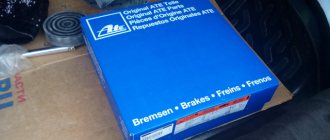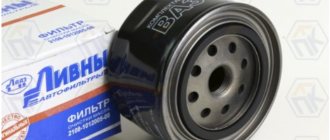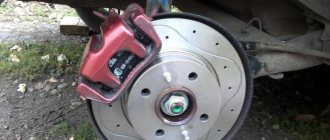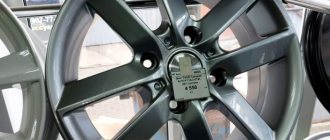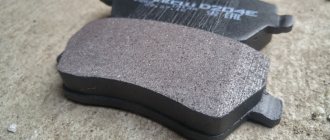Rear brakes on cars of the Lada Vesta family are of two types - disc and drum, respectively, and their replacement will differ from each other. Disc brakes are installed from the factory on models with a 1.8-liter engine, while other trims are equipped with drum brakes. AvtoVAZ explains this by saying that for a Lada Vesta with a 1.6-liter engine (106 horsepower), a drum brake system will be sufficient, and such a move, in turn, will reduce the final price of the product. It is worth noting that, if desired, the brake system can be replaced and discs installed instead of drums, however, such tuning will be a waste of money and will only bring moral satisfaction to the owner.
Replacing drum brakes with disc brakes Lada Vesta
The Lada Vesta braking system consists of brake mechanisms and electronic driver assistance systems. The car is equipped with disc brakes at the front and drum braking devices at the rear. Every owner should know what rear brakes are installed on the Lada Vesta and how to service them.
Main differences between disc and drum
The braking mechanism consists of several parts and differs in two types of design.
The disk unit has an open design, allowing the device to operate for a long time without overheating.
When you press the brake pedal, the brake pads are pressed against the disc mounted inside the wheel rim using a caliper.
The degree of compression of the disc by the calipers is very high, which allows the car to brake more efficiently. As a result of heavy loads, the mechanism has a relatively short resource.
The drum mechanism has a closed cylindrical body, which prevents the entry of dirt and dust and has a long working life. The brake pads are pressed against the inner surface of the drum, causing the car to stop. The pressing force of the elements is comparatively lower than that of analogues with a disk, therefore such mechanisms are considered less effective.
The combination of front discs and rear drums is optimal in terms of efficiency and durability. This version of the Lada Vesta justifies itself with its reasonable price and reliability.
Rear brakes on Lada Vesta
Each car enthusiast can decide for himself whether to install drum or disc rear brakes on his car. He will not feel much difference from replacing the elements.
Replacing drum brake pads
Before starting work, the handbrake lever should be completely lowered down. The installation process has its own procedure:
- remove the rear wheel;
- using a slotted screwdriver, unscrew the ratchet nut that adjusts the length of the spacer bar;
- remove the block and replace it with a new one;
- install the drum back;
- tighten the bearing nut.
DIY car arch repair video
Replacing the pads involves installing them on both wheels at the rear, otherwise the car will brake with different forces on the wheels and may lose control.
Lada Vesta rear brake pads must be replaced every 50-60 thousand km. But this does not mean that they do not require additional periodic inspection.
Approximately every 15-20 thousand kilometers, it is necessary to inspect the important parts of the car. It is not recommended to buy spare parts at street car markets; there is a possibility of stumbling upon a low-quality product.
The cost of a set of rear brake pads for a drum is about a thousand rubles.
Standard front pads - article number and price
On a Lada Vesta car of any modification and in any body, consumables manufactured by Renault are installed - be it a sw station wagon, sw cross, sport, etc. On the Lada Vesta St. Cross, the consumable parts can withstand the load - they wear out at the same rate as on other modifications.
Standard components of the Lada Vesta brake system received catalog number 8200 432 336. Their cost in stores starts at 1,400 rubles and ends at approximately 2,000 rubles.
The best front brake discs
Here are the best front brake discs.
Alnas Sport 2112-3501070-01
These are high-quality cast iron discs that have a long service life. Spare parts provide smooth braking without vibrations. The elements quickly “grind in” to the system and fit like a glove.
The model is characterized by a long warranty period. However, it only applies when parts are installed at a service center, for which there must be appropriate documents.
Alnas Sport 2112-3501070-01
Characteristics:
- material – cast iron;
- minimum thickness – 18;
- number of holes for fasteners – 4;
- centering diameter – 58.5 mm;
- weight – 12 kg.
pros
- excellent quality;
- increased strength;
- long operational period;
- smooth braking without vibration;
- acceptable cost.
Minuses
- If you install it yourself, the manufacturer's warranty will no longer apply.
ATE PowerDisc
These are high-quality German-made brake discs made of high-carbon cast iron. The products are characterized by increased strength, resistance to low temperatures and temperature changes. The elements provide smooth and effective braking without runout. The model is characterized by a long operational period and reasonable cost. The products have reliable protection against the accumulation of gas cushions between these parts and the pads. Therefore, the braking system will not lose its effectiveness due to this.
Signs of pad wear
Before each vehicle departure, check the amount of fluid in the brake system reservoir. The level must be above the min mark. If it is lower, this is one of the signs of abrasion.
Another sign is that the pedal softens at first and then drops. The distance from pressing the pedal to stopping the car increases noticeably.
When the linings of one of the wheels wear below a critical value, the car can be felt skidding in the opposite direction.
If such signs, knocks and squeaks are detected, the pads are inspected. Check whether their wear has reached the limit values. For overlays the thickness limit is 2 mm. The maximum size of the drum rubbing surface is 204.45 mm.
The best rear brake discs
Here are the best items for the rear axle.
TRW DF7257
These are high-quality wear-resistant products that provide fast and easy braking without vibration or wobble. The elements do not overheat even after driving for many hours. The parts are characterized by increased strength and long service life.
Characteristics:
- material – cast iron;
- minimum thickness – 8.5;
- number of holes for fasteners – 5;
- centering diameter – 62 m;
- weight – 10.8 kg.
pros
- high quality;
- reliability;
- absence of beating and vibration during braking;
- do not make unpleasant sounds;
- long working life;
- good equipment;
- proven brand.
Minuses
- there are fakes;
- high price.
BM BDV 292
This is a high-quality model that is characterized by wear resistance. The spare part will serve for a long time even under conditions of increased loads and daily use of the vehicle. The model provides high-quality braking even if the car is moving at high speed. In this case, vibration and beating do not occur.
Characteristics:
- material – cast iron;
- packaging – 1 pc.;
- packaging – 27.6x27.6x3 cm;
- weight with packaging – 14.4 kg.
pros
- long service life;
- fast braking even at high speed without beating or vibration;
- there are no squeaks or other unpleasant sounds;
- reliability;
- excellent quality.
Safety
The new Lada Vesta is equipped with an adaptive system that can facilitate the braking process. The built-in electronics are configured to detect the speed and force of the driver pressing the pedal, due to which it instantly reacts and speeds up the stopping of the car.
Also, the 2015 Lada Vesta has a built-in electronic force distribution system. Its work begins at a time when the braking forces of the rear and front wheels exceed the norm. At such moments, the system begins to redistribute the load, due to which driving continues without skidding and other problems that may arise while driving.
According to the presented characteristics, the new Lada also has a stability control system. It performs the following actions:
- braking certain wheels depending on the situation,
- change in torque
- redirection of the front wheels.
Thanks to this, when turning, the new Lada Vesta does not begin to move away from the trajectory due to the braking of the rear inner wheel. All this ensures a high level of driving safety, which distinguishes the car from previous versions. Also, the built-in electronics allow you to maintain good vehicle controllability.
More details about Lada “Vesta” cars
The best front wheels for Lada Granta
When compiling a kind of rating, we studied reviews of owners, parameters, price and quality. Among the best analogues, four candidates can be distinguished.
Sport Alnas, from RUB 1,700. (21-12-350-1070-01)
Brake discs made of cast iron are characterized by a long service life. The parts quickly grind into mating elements and fit well into place. It is worth noting that the manufacturer's warranty does not apply to self-installation. Thickness – 18 mm, number of mounting slots – 4, weight – 12 kg. The owners consider the optimal combination of cost and quality indicators to be the main advantage.
Brembo Max, from RUB 2,800. (09-8903-75)
Discs from an Italian manufacturer show efficient operation, there are no beats or vibrations. The elements are easy to install. If there are unpleasant sounds after the replacement, do not be upset; after 2-3 days they disappear.
Brief characteristics:
- thickness (mm) – 18;
- mounting holes – 4 pcs.;
- centering (mm) – 58.5 mm;
- tightening torque – 75.
Bosch, from 1,500 rub. (098647-9346)
Budget discs that are not inferior in quality to expensive analogues. When braking, vibration moments and beating do not occur. The advantages of the devices include increased strength and durability. The products are made of cast iron (thickness is 18 mm, with a centering diameter of 58.5 mm). Good protection against counterfeiting, available at most points of sale.
ATE Power Disk, from RUB 3,500. (24.0120-0187/1-420187)
The best brake discs for the front wheels of Lada Granta cars are made in Germany. The advantages include increased strength, smooth and effective brake operation. These devices are resistant to temperature fluctuations, which is important for the harsh climate of Russia. Models made of high-carbon cast iron have thoughtful protection against the accumulation of a gas cushion between the discs and pads.
Options:
- minimum thickness – 23 mm;
- mounting sockets – 5 pcs.;
- weight – 8.3 kg;
- centering – 63.5 mm.
Replacing brake discs
You can replace the brake discs yourself. The main thing is the availability of a place for work, as well as the necessary materials and tools. When performing the corresponding manipulations, you should remember that the procedure for replacing the front and rear parts of a car has some differences.
Required materials and tools
To replace brake discs, you will need the following materials and tools:
- the spare parts themselves;
- jack;
- wrenches designed for nuts 7, 13 and 17 mm, as well as a wheel wrench;
- torx head t12 for unscrewing and dismantling the caliper;
- lubricant;
- extension;
- ratchet;
- hammer.
Replacing front brake discs
To replace the front elements, proceed as follows:
- Remove the wheel and raise the vehicle using a jack.
- Remove the guide fasteners and swing out the brake pad to remove the old pads.
- Place the bracket on the pendant.
- Unscrew the disk fasteners, lubricate them to facilitate dismantling, and then remove the elements - if the elements cannot be removed, carefully hit them with a hammer from the back side.
- Install new parts and tighten fasteners.
Attention! When performing the disc replacement procedure, it is also recommended to install new pads.
Replacing rear brake discs
To change the rear elements, follow these instructions:
- remove the wheel and lift the vehicle using a jack;
- remove the caliper, pads and disc;
- install new spare parts - first install the disc, then assemble the caliper and secure the pads.
What signs indicate the need to replace the pads?
You can guess about an upcoming visit to a service station or the need for independent replacement by the presence of the following signs:
• The appearance of a strong squeak when braking; • the handbrake, despite tightening it, no longer holds the car on an incline; • in the case of drums, there is a characteristic sign - grinding and noise appears from the rear wheels of a car standing on a minimal slope.
In addition, pad wear manifests itself in the form of an increase in braking distance. Due to design features, wear of the rear pads when braking at high speed manifests itself in the rear axle of the car drifting and turning across the road.
The manufacturer himself recommends monitoring the condition of the brake system every 60-80 thousand km. This figure is individual, and largely depends on driving habits, the predominance of highway or city cycles, and other factors (including the quality of the pads themselves and the condition of the brake discs/drums).
Which discs are better for Grants in different conditions?
Three different types of brake discs are installed on the Granta. Often users install similar parts from foreign cars to speed up the ride or to save money.
In the city and on the highway
Under normal operating conditions, factory cast iron discs or any other equivalents are suitable. If you have the original 13s and are not enough, change to a 14th size. It's easy to change them, and the car will brake much better.
Remember that you have an inexpensive sedan, not a race car. Do not overheat the brakes and if you drive through a water obstacle in the form of a puddle, dry them by briefly pressing the brake pedal. It doesn't make sense to pay more for ceramics for quiet use.
For lovers of fast driving
If you like to race, think about good brakes. For this purpose, 15-size perforated wheels with grooves or other sports wheels are suitable for the Granta. If you have a passion for this car and you are tuning it, install ceramics. Although it is expensive and needs to be warmed up, it is best suited for sports use.
Don't expect that having an ABS system will save you money on brakes. It prevents wheel locking, but does not improve braking performance in any way.
Off-road
If you want to try a front-wheel drive sedan as a trophy truck, then there is no point in thinking about good brakes. The speed will be comparable to a pedestrian, so you can install cheap brakes or leave standard (factory) ones if they are in good condition. If you're thinking of taking part in a rural rally at high speed, think about good wheels.
If the car is used for fast driving, do not skimp on the brakes. And it’s better not to drive. “Granta” is not intended for this, the security level is also low. The guarantee of your life is impeccable compliance with traffic rules. For fast driving, racing tracks have been built taking into account safety requirements. It is better to practice extreme driving on them.
Device
The unit consists of the following parts:
- The Lada Vesta brake drum with a bearing and an ABS ring is mounted on the rear pillar axle. The body of the part has four threaded holes for fastening the wheel. It has a cylindrical shape and is cast from cast iron. The inner surface is carefully processed to eliminate roughness.
- The pads are semicircular in shape, with a diameter 2 mm smaller relative to the inner diameter of the drum. Friction linings are attached to the outer sides. The upper part of the pads is connected to the brake cylinder, and the lower part touches the mechanical stop.
- The cylinder has two pistons that extend in opposite directions.
- The ABS system contains 2 elements - a speed sensor and an impulse rotor (a metal toothed ring). The sensor is attached to the wheel stand guard. The rotor is pressed onto the outside of the drum bearing.
- The spacer bar consists of a threaded rod that screws into a hollow tube. A ratchet wheel is pressed onto the surface of the tube.
- The upper coil spring returns the pads to their original state after removing the force from the brake pedal. The lower spring maintains constant pressure on the lower ends of the pads against the stopper.
Photo source: https://www.drive2.com/l/530431348347765662/
Knowing the design of the node, you can understand the causes of its problems and quickly fix them.
What front brake discs should be installed on the Lada Granta
The front wheels of the Lada Granta are equipped with disc shoe brakes. What makes the pedal informative is that it makes it easy to calculate where to stop.
The power reserve with original parts can range from 50 to 120 thousand km. But sooner or later the need for replacement arises.
You can divide all supplied spare parts into two main categories: original and analogues. The former are more expensive. But at the same time, their maximum mileage is usually an order of magnitude greater than their analogues. There is multi-stage quality control in production. The downside is the high cost. Sometimes it is 2-3 times more than analogues.
The latter are distinguished by their availability. But not all parts are reliable. It is best to give preference to well-known brands that have proven themselves on the positive side.
Original
The advantage is exact compliance with the specified dimensions. After purchasing the part, there is no need to adjust it to size or grind it down:
How does Lada take care of your safety?
Lada Vesta has a special adaptive system in its arsenal, which is designed to ensure maximum convenience of the braking process. The car has built-in electronics that determine how fast and how hard the driver presses the pedal. This allows you to achieve the fastest and most timely stopping of the car in any situation. The computer has an instant response and takes care of the safety of the driver of the Lada Vesta continuously throughout the entire trip.
Lada Vesta is also equipped with a built-in electronic system designed to distribute forces. It turns on at the moment when the load on the disc and drum brakes goes beyond the established norm. This system redistributes the load level, and Lada Vesta continues to move without skidding.
In addition to all the innovations listed, the Lada Vesta has a directional stability system, which is responsible for the following vehicle functions:
- if necessary, certain (depending on the situation) wheels of the Lada Vesta independently brake and create optimal conditions for movement;
- torque may vary;
- the front wheels of Lada Vesta are independently redirected in the correct direction.
Such properties allow the Lada to keep the right course during sharp turns. The trajectory of movement does not deviate from the norm due to the braking of the rear wheel located inside. The use of this technology allows the driver to have good control of the Lada Vesta at all times.
What rear brake discs can be installed on the Lada Granta
Despite the fact that this car belongs to the budget class and is one of the cheapest among those sold in the Russian Federation, it is equipped with rear disc brakes. Which implies the need to replace individual components. The price of parts depends on their type, as well as other factors.
It is important to remember: the front and rear discs differ in the diameter of the mounting holes and other parameters. Installation can be done by yourself. The process itself is simple. But it requires some preparation. It is important to decide on a budget for parts in advance. All of them are divided into two main categories - analogues and originals. They differ in price and quality.
There are many types of discs. These are ventilated, with notches and various others. If the driver practices an aggressive driving style, then you should opt for ventilated models. They cool faster. They have more resources. The replacement process is no different from the others.
Original
Buying original parts is a good solution if you have an unlimited budget. AvtoVAZ products are quite expensive. Especially when compared with analogues from China. Original TD:
NameArticle Cost, rubles
| AvtoVAZ brake disc (can be marked as Renault) | 432007595R | 9 thousand rubles per pair |
Analogs
The cost of original components is an order of magnitude higher than analogues. Therefore, the choice of many vehicle owners falls on substitutes. The most advantageous offers:
NameArticle Cost, rubles
| A.S.P. | 2702220 | 2 thousand rubles. for 1 piece |
| B.M. | BDV 885 | 1 thousand rubles for 1 piece. |
| Hella | 8DD355109331 | 1.6 thousand rubles for 1 piece. |
Analogues on calipers and drums
There are analogues for Lada Vesta drum brakes on the market:
- Fenox (BP53013). Cost 980 rubles; (BP53168) Price 1340 rubles;
- Hella Pagid (8DB355002-411). Price 2780 rubles;
- JP Group (1563900810). Price 1490 rubles;
- Mintex (MFR516). Price 2550 rubles;
- Patron (PSP8742). Price 730 rubles;
- Remsa (4137.00). Price 1110 rubles;
- Textar (91057300). Price 3130 rubles.
There is an analogue of Lada Vesta disc brakes. It is produced by TRW, article number gdb1384, cost – 1400 rubles.
According to information provided by the manufacturer of the Lada Vesta, any configuration comes with an ABS+BAS braking system. Moreover, the type of brake pads on the front wheels will be different from those installed on the rear wheels. This is due to the lower cost of the mechanisms that were used on previously created cars of this brand. On the front wheels, the braking system of the Lada Vesta will be a disc mechanism, and on the rear wheels it will be a drum mechanism. In addition to the anti-lock braking system with emergency brake assist (ABS+BAS), all trim levels (Classic, Comfort, Luxury) will be equipped with the following modules:
- Electronic brake force distribution (EBD);
- Hill Start Assist (HSA);
- Exchange rate stability system (ESC);
- Traction control system (TCS).
Replacing front brake discs
The replacement algorithm includes the main steps:
- it is necessary to remove the wheel and jack up the car;
- the old brake pads are removed - to do this, the guide bolts are unscrewed and the caliper is folded back;
- The bracket is carefully hung on the suspension, after which you can begin to remove the disk - two nuts are unscrewed;
- if for some reason the disk cannot be removed from the bolts, you need to lightly hit it with a hammer from the reverse side;
- The new disk is carefully installed.
The nuts are screwed into place. It is advisable to pre-lubricate the threads with graphite lubricant. This will prevent souring. It is advisable to change the pads along with the discs.
Replacing rear brake discs
The algorithm for replacing rear brake discs is as simple as the front ones. The process is similar. Its main stages:
- it is necessary to remove the wheel to gain access directly to the part - the car is raised on a jack or lift;
- the caliper is removed along with the pads - you can place it side by side or hang it on a spring;
- use an open-end wrench to unscrew two nuts;
- a new disk is installed.
Assembling the caliper, installing the pads - everything is done in the reverse order. It is necessary to ensure that the thickness of the brake disc corresponds to that specified by the manufacturer. If you have difficulty removing the pads, you need to press in the cylinder with a screwdriver. If difficulties arise with unscrewing threaded connections, you need to use WD-40.
Possible difficulties and solutions
Difficulties in dismantling a worn element may arise at the initial stage - bending of the edges of the plate. It is not always possible to successfully catch the edge and bend the material in the desired direction. If the owner cannot get a grip with pliers, you can use a rigid screwdriver or pliers, placing the working rod in the eye, after which the lever method is used to bend it.
- It is always better to use original spare parts or suitable replacements;
- The rear wheels are securely fixed with wheel chocks;
- Replacement is carried out only comprehensively;
- After completing the procedure, it is necessary to monitor the brake fluid level.
You should not worry if you experience an unpleasant sound after replacement. New elements should get used to the brake discs after several thousand kilometers.

